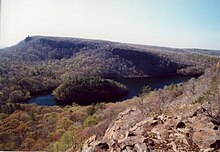
Back كتلة صدعية Arabic Blok (geoloji termin) Azerbaijani স্তূপ পর্বত Bengali/Bangla Kra (geologie) Czech Bruchtektonik German Bloque de fallas Spanish Pangasmäestik Estonian قطعه گسلی Persian Siirroslohko Finnish भ्रंश-खण्ड Hindi


Fault blocks are very large blocks of rock, sometimes hundreds of kilometres in extent, created by tectonic and localized stresses in Earth's crust. Large areas of bedrock are broken up into blocks by faults. Blocks are characterized by relatively uniform lithology. The largest of these fault blocks are called crustal blocks. Large crustal blocks broken off from tectonic plates are called terranes.[1] Those terranes which are the full thickness of the lithosphere are called microplates. Continent-sized blocks are called variously microcontinents, continental ribbons, H-blocks, extensional allochthons and outer highs.[2]
Because most stresses relate to the tectonic activity of moving plates, most motion between blocks is horizontal, that is parallel to the Earth's crust by strike-slip faults. However vertical movement of blocks produces much more dramatic results. Landforms (mountains, hills, ridges, lakes, valleys, etc.) are sometimes formed when the faults have a large vertical displacement. Adjacent raised blocks (horsts) and down-dropped blocks (grabens) can form high escarpments. Often the movement of these blocks is accompanied by tilting, due to compaction or stretching of the crust at that point.
- ^ A crustal block may or may not also comprise a tectonostratigraphic terrane that has a specific geologic definition. Bulter, Robert F. (1992) "Chapter 11: Applications to Regional Tectonics" Paleomagnetism: Magnetic Domains to Geologic Terranes Blackwell, pp. 205–223, page 205, archived here by Internet Archive on 26 October 2004
- ^ Péron-Pinvidic, Gwenn; Manatschal, Gianreto (2010). "From microcontinents to extensional allochthons: witnesses of how continents rift and break apart?". Petroleum Geoscience. 16 (3): 189. Bibcode:2010PetGe..16..189P. doi:10.1144/1354-079309-903. S2CID 131142997.